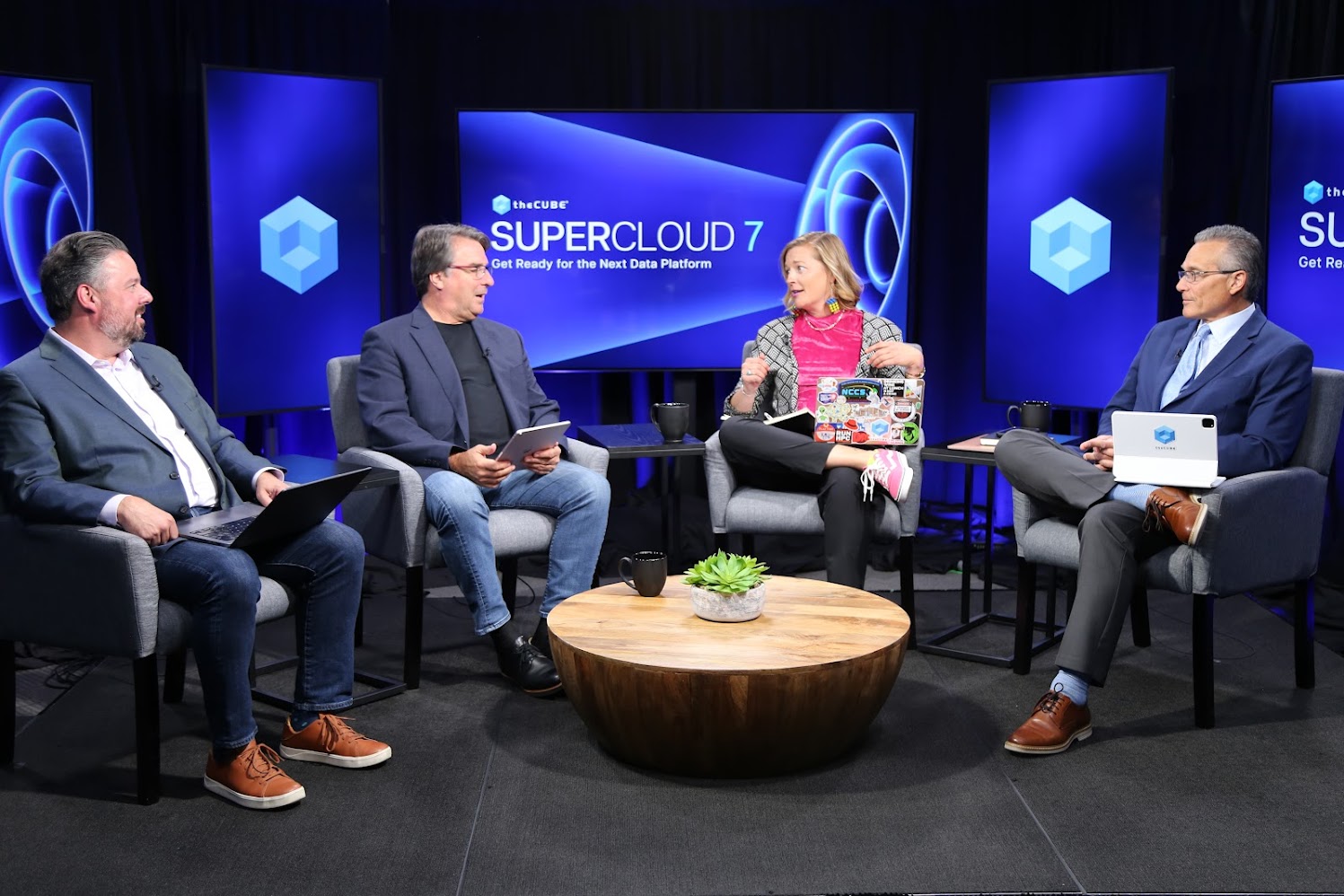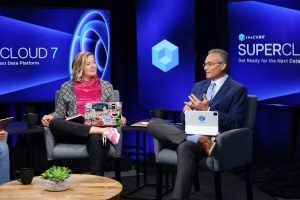 CLOUD
CLOUD
 CLOUD
CLOUD
 CLOUD
CLOUD
The era of big data has morphed into the era of generative artificial intelligence powered by data innovation.
This was of one of the conclusions drawn from the Supercloud 7: Get Ready for the Next Data Platform event, as theCUBE Research Analysts looked back on the first day of discussion and prepared for Day Two.
“Three years ago [big data] really started to kick into high gear, and now I think you’re seeing it playing out where all who have been grinding in those days have a total tailwind,” said theCUBE Research Analyst John Furrier (pictured, second from left). “You’ve got cloud scale, distributed computing, architectures on-prem and generative AI with all that horsepower. It’s just a lucky strike for anyone who’s innovating with data. We’re going to see a Cambrian explosion of data innovation and we’re just scratching the surface.”
Furrier spoke during the kickoff discussion for Day Two of Supercloud 7. He was joined by theCUBE Research’s Dave Vellante (far right), Savannah Peterson (second from right), and Rob Strechay (far left), as they discussed key learnings from the event’s opening day of interviews.
Furrier described how the explosion of data innovation has also led to the rise of data operating systems. Generative AI has changed how enterprises view big data and the structures necessary to realize its value.

TheCUBE Analysts Savannah Peterson and Dave Vellante talk about big data at Supercloud 7.
“It’s just starting,” Vellante said. “The ‘big data’ era sort of put that term in everybody’s minds, but they couldn’t relate to it. Generative AI democratizes that, puts it in everybody’s hands. It humanizes the whole data space and what we’re calling intelligence.”
This synergy between data and AI was a central part of the discussion during Supercloud 7, as Peterson noted.
“As we do these Supercloud events…there are very much overlapping themes between AI and data,” she said. “AI requires a lot of data and there’s more data now than ever. AI is not the only reason these data conversations needed to happen and matter. This needed to happen because of where we’re at in innovation.”
The innovation playing out in the data world is transforming IT systems and architectures. The result has been a renewed focus on interconnectivity and cross-platform applications, according to Strechay.
“Data needs to be in your generative AI application, because that data is super valuable,” he said. “How are you going to connect that all up? It’s not all going to move to the cloud. It’s not all going to move to one data warehouse. It’s got to be meshed together in some way, shape or form.”
Meshing various data stores together will require constructing new systems that can facilitate data access and drive AI engines in productive ways, a process not unlike building the cityscape.
“It’s like when you go into downtown Boston and there’s a lot of construction, and they’re fixing the pipes and you’ve got to go around everything,” Furrier said. “That’s kind of like the industry right now. Why are they digging out the streets? That’s what companies are going through, they have to get down and dirty and fix plumbing.”
Supercloud 7 featured interviews with several organizations that were in the process of building the infrastructure for powering data and AI. One example can be found in Salesforce Inc. which is leveraging its Data Cloud, automation and AI to deliver new solutions for enterprise IT.
“What they’re doing is essentially building their own data cloud,” Vellante said. “They’re harmonizing that data, they’re connecting to the legacy Salesforce app. Within their own world, which continues to grow, they are actually building the next data platform. That’s the one to watch.”
With generative AI playing a major role in the build-out of data platforms, attention is also being paid to new developments in the field of AI itself. TheCUBE analysts agreed that AI will ultimately become adapted as a natural interface without the need for prompts or programming by the average user.
“The interface with AI is not going to be a prompt,” Strechay explained. “That’s going to go away and we’re going to be interfacing with it from voice, from natural language, from different ways of interfacing with it through other applications where we won’t even know that it’s happening.”
While AI may ultimately become simpler to use and a part of daily life, the infrastructure to drive it is becoming more complicated by the day. The explosion of data and its central role in powering AI applications is leading to new platforms that will likely make the jobs of IT administrators more complex.
“How do we deal with complexity in this industry?” Vellante said. “We layer on more complexity.”
Here’s the complete video interview, part of SiliconANGLE’s and theCUBE Research’s coverage of the Supercloud 7: Get Ready for the Next Data Platform event:
Support our mission to keep content open and free by engaging with theCUBE community. Join theCUBE’s Alumni Trust Network, where technology leaders connect, share intelligence and create opportunities.
Founded by tech visionaries John Furrier and Dave Vellante, SiliconANGLE Media has built a dynamic ecosystem of industry-leading digital media brands that reach 15+ million elite tech professionals. Our new proprietary theCUBE AI Video Cloud is breaking ground in audience interaction, leveraging theCUBEai.com neural network to help technology companies make data-driven decisions and stay at the forefront of industry conversations.